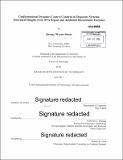| dc.contributor.advisor | Catherine L. Drennan. | en_US |
| dc.contributor.author | Setser, Jeremy Wayne | en_US |
| dc.contributor.other | Massachusetts Institute of Technology. Department of Chemistry. | en_US |
| dc.date.accessioned | 2014-10-21T17:27:01Z | |
| dc.date.available | 2014-10-21T17:27:01Z | |
| dc.date.copyright | 2014 | en_US |
| dc.date.issued | 2014 | en_US |
| dc.identifier.uri | http://hdl.handle.net/1721.1/91114 | |
| dc.description | Thesis: Ph. D., Massachusetts Institute of Technology, Department of Chemistry, 2014. | en_US |
| dc.description | Cataloged from PDF version of thesis. Vita. | en_US |
| dc.description | Includes bibliographical references. | en_US |
| dc.description.abstract | Chemical reactions allow biological systems to function. The majority of these biochemical reactions occur due to the work of protein catalysts known as enzymes. These biocatalysts are often thought of as pre-formed, static 'locks' that bind, and subsequently transform, their substrate molecule 'keys'. However, scientists are increasingly finding that dynamic movements of enzymes are a crucial aspect of catalysis. One such example of a system that relies on conformational flexibility is the human DNA repair protein alkyladenine DNA glycosylase (AAG). To efficiently repair DNA, AAG must search the million-fold excess of unmodified DNA bases to find a handful of DNA lesions. Such a search can be facilitated by the ability of glycosylases, like AAG, to interact with DNA using two affinities: a lower-affinity interaction in a searching process, and a higher-affinity interaction for catalytic repair. We have captured crystallographic snapshots of AAG bound to DNA in both high- and lower-affinity states. These depictions reveal several significant and unexpected protein structural rearrangements, providing molecular insight into the DNA-searching process adopted by AAG. By combining these new insights with existing biochemical and structural data, we are able to relate AAG to the big picture question of how DNA binding proteins find their binding sites in the vast expanse of the genome. In another study, a member of a biosynthetic pathway for antibiotic natural products, called kutznerides, was shown to be dependent on conformational changes. The enzyme in question, KtzI, uses a bound flavin cofactor, reducing equivalents from NADPH, and molecular oxygen to install a hydroxyl group on the side-chain nitrogen of the amino acid L-ornithine, which is subsequently incorporated into the kutzneride scaffold. KtzI was structurally characterized after being subjected to various chemical and environmental factors, capturing the enzyme in several states along its catalytic trajectory. These states suggest that a novel conformational change of both the protein backbone and the flavin moiety must take place in order to complete the enzymatic cycle of KtzI. This drastic rearrangement was also shown to be chemically interchangeable in the protein crystal, suggesting that these dynamic motions are catalytically relevant. | en_US |
| dc.description.statementofresponsibility | by Jeremy Wayne Setser. | en_US |
| dc.format.extent | 156 pages | en_US |
| dc.language.iso | eng | en_US |
| dc.publisher | Massachusetts Institute of Technology | en_US |
| dc.rights | M.I.T. theses are protected by copyright. They may be viewed from this source for any purpose, but reproduction or distribution in any format is prohibited without written permission. See provided URL for inquiries about permission. | en_US |
| dc.rights.uri | http://dspace.mit.edu/handle/1721.1/7582 | en_US |
| dc.subject | Chemistry. | en_US |
| dc.title | Conformational dynamics control catalysis in disparate systems : structural insights from DNA repair and antibiotic biosynthetic enzymes | en_US |
| dc.type | Thesis | en_US |
| dc.description.degree | Ph. D. | en_US |
| dc.contributor.department | Massachusetts Institute of Technology. Department of Chemistry | |
| dc.identifier.oclc | 892967382 | en_US |
